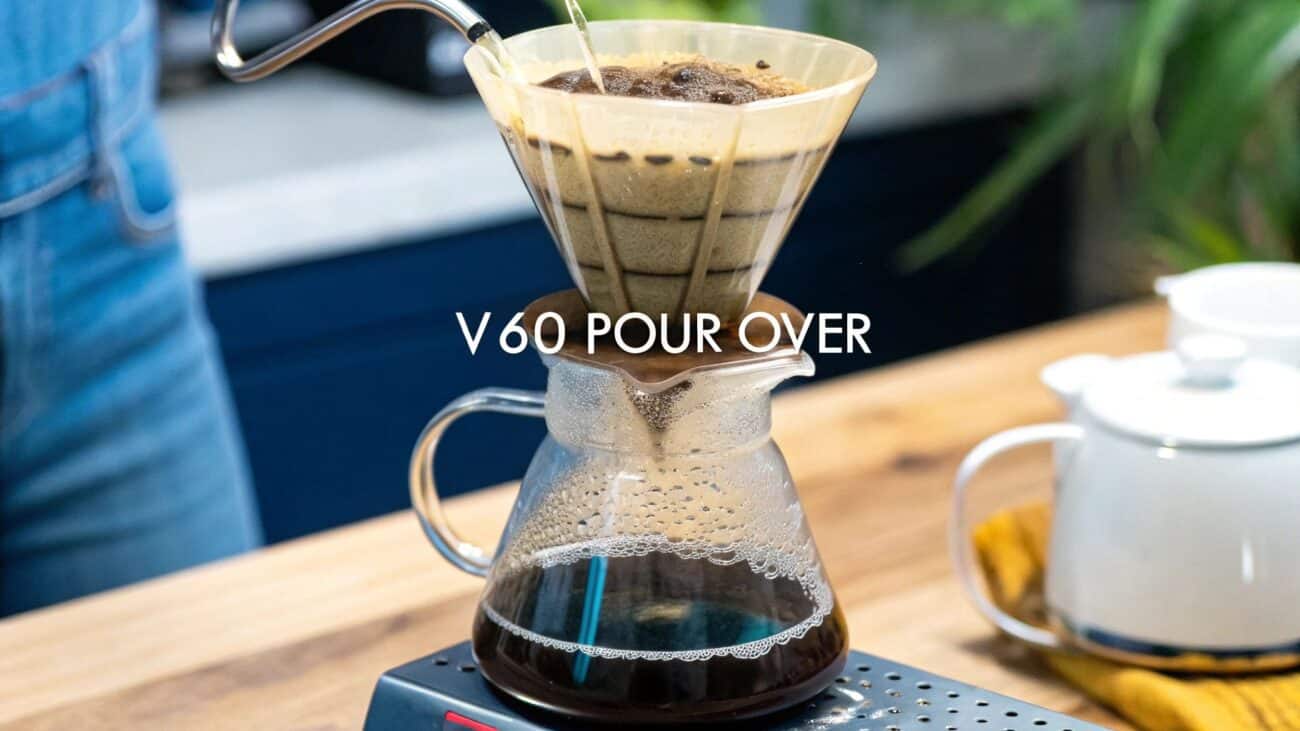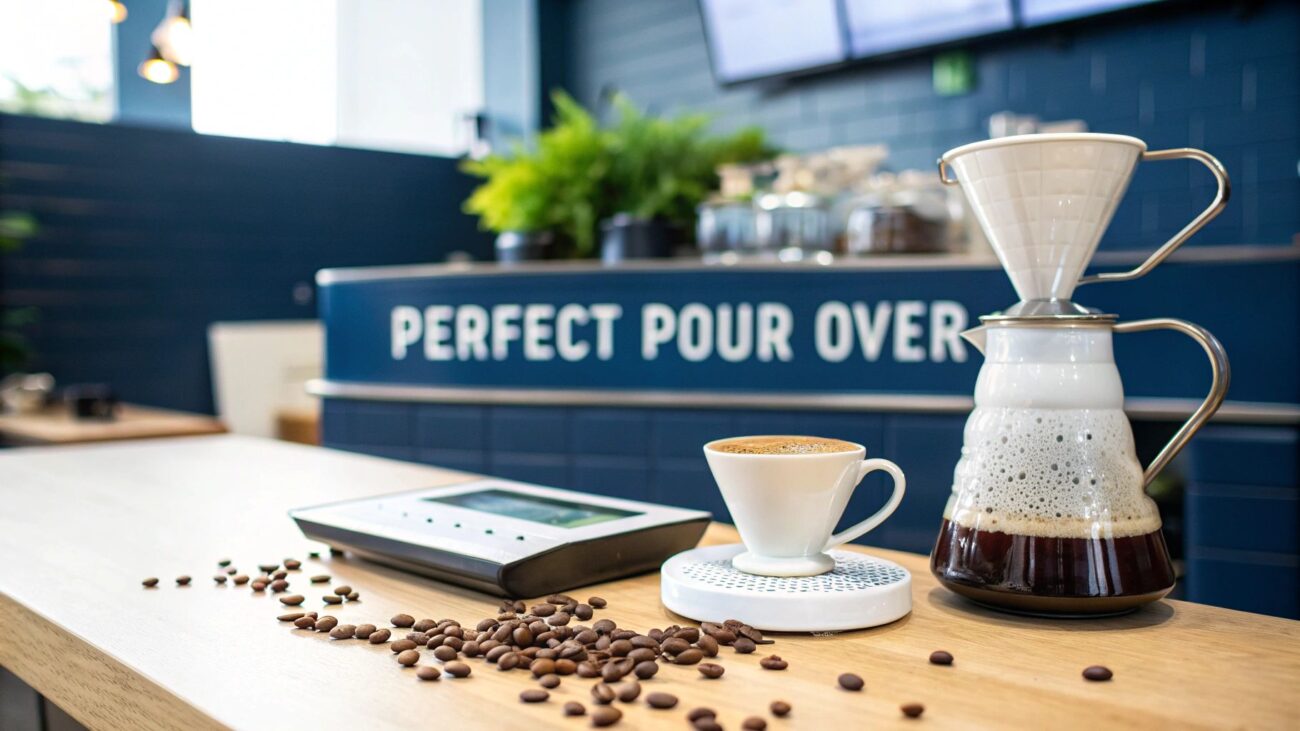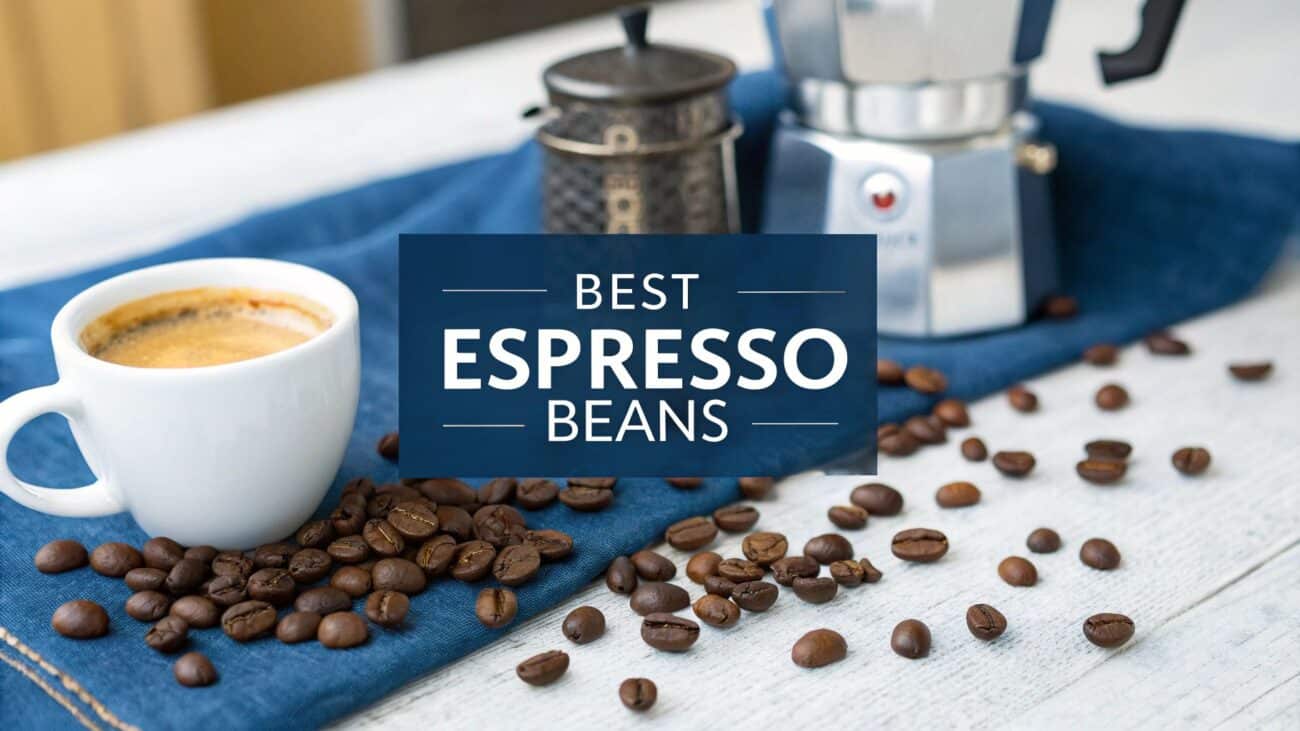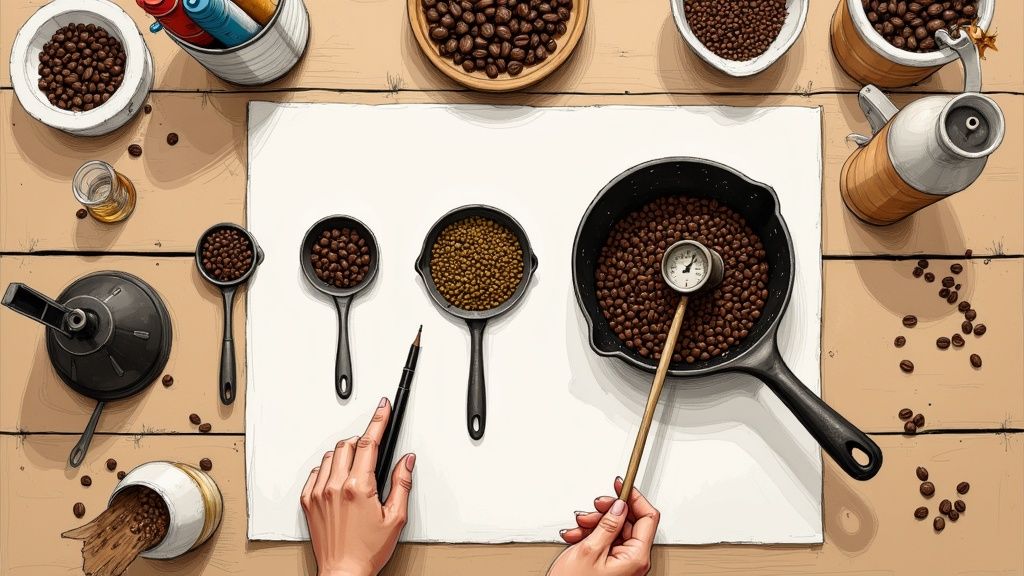A Guide to Home Coffee Roasting Equipment
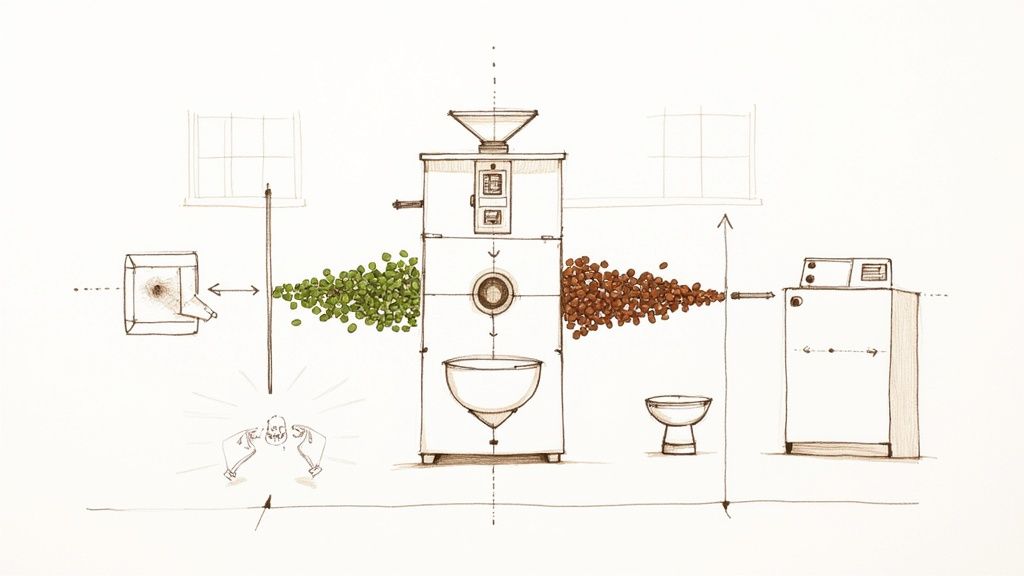
Roasting your own coffee at home is a game-changer. It’s the difference between listening to a recording and playing the music yourself. Suddenly, you have complete control over flavour, freshness, and even cost, turning your daily coffee ritual into a truly rewarding craft.
This is your key to experiencing coffee as it's meant to be: incredibly fresh, roasted precisely to your taste, and often for a fraction of the price of shop-bought speciality beans.
Why Roast Your Own Coffee at Home
Stepping into the world of home roasting is less about making coffee and more about creating it. You’re no longer just playing the hits; you’re writing the song. This shift gives you absolute control over the final cup, transforming a simple daily habit into a deeply satisfying and creative process.
The biggest win? Unlocking a level of freshness that pre-packaged coffee just can’t touch.
Roasted coffee is a perishable product. Its vibrant aromas and complex flavours start to fade just days after roasting. When you roast your own beans, you get to experience coffee at its absolute peak, usually within 24 to 72 hours of the roast. This freshness unveils those subtle tasting notes—from fruity and floral to rich and chocolaty—that are often lost in bags that have been sitting on a shelf for weeks.
Unlocking Flavour and Saving Money
Beyond the incredible improvement in taste, roasting at home is a journey of discovery. You can experiment with green beans from countless origins, each with its own unique character. This hands-on process lets you fine-tune your roast profile, deciding whether you want a light, zesty roast or a dark, bold one. You become the artisan.
For anyone new to this, exploring a variety of high-quality green beans is the perfect first step. You can learn more about finding the best specialty coffee beans to kickstart your journey.
There's also a compelling financial reason to get started. With café prices on the rise, many of us are looking for ways to create a barista-quality experience without leaving the house.
A recent report highlighted that over half of UK coffee drinkers now prefer their coffee at home, with many households allocating a weekly budget specifically for it. This has spurred interest in home coffee roasting equipment as a way to achieve superior taste cost-effectively.
This shift means that an initial investment in a roaster can lead to significant long-term savings. Green coffee beans are substantially cheaper than their roasted counterparts, and buying in bulk reduces the cost even further. It’s a trend that’s reshaping how we think about our daily brew, making it easier than ever to get started.
Understanding Different Types of Home Roasters
Stepping into the world of home coffee roasting can seem a little daunting at first, but it's simpler than you might think. Most of the equipment you'll come across falls into two main camps: air roasters and drum roasters. Each one takes a totally different path to turn green beans into those fragrant, brown gems we all love.
Think of an air roaster as a fancy, super-powered popcorn popper built just for coffee. It shoots a powerful stream of hot air upwards, which heats the beans while making them dance around. This constant movement ensures every single bean gets roasted evenly—a method known as fluid bed roasting.
A drum roaster, on the other hand, is more like a miniature tumble dryer. You place the beans inside a rotating, heated drum. As it turns, the beans tumble against the hot metal surface, roasting through a mix of direct contact (conduction) and the hot air inside (convection).
Air Roasters: The Fast and Beginner-Friendly Choice
For many people just starting out, air roasters are the perfect entry point. They’re usually much quicker, finishing a roast in as little as 6 to 12 minutes, and are generally simpler to operate. Because they rely entirely on hot air, the resulting roast tends to be very clean and bright, which does a fantastic job of highlighting the delicate, acidic notes in beans from places like Ethiopia or Kenya.
They're also more compact and kick out less smoke than drum roasters, making them a much better fit for the average kitchen. The main trade-off? Batch size. Most home models can only handle about 100g of green beans at a time. That’s enough for a few cups, but you might find it a bit limiting if you get through a lot of coffee.
As you can see, it really comes down to a choice between the speed and smaller capacity of an air roaster versus the larger batches and longer, more hands-on roast times of a drum model.
Drum Roasters: The Artisan's Preference
If you're after greater control and want to roast in bigger batches, a drum roaster is the natural next step. These machines give you a more traditional roasting experience, allowing for slower roasts that really build body and sweetness. This approach is fantastic for bringing out those rich, chocolatey, and nutty flavours in your beans.
While they do need more space and a bigger initial investment, drum roasters give you the power to fine-tune your roast with incredible precision. You can manually tweak the heat and airflow to shape how the bean develops its flavour. If you're serious about mastering the craft, you can dive deeper into how these adjustments work by exploring our guide on coffee roasting profiles explained.
The real magic of a drum roaster is the control it offers during the 'development phase'—that critical time after the beans' first crack. This is where all the nuanced flavours are truly formed, something that's much harder to manage with a basic air roaster.
A quick word of warning, though: drum roasters need excellent ventilation. They produce a fair amount of smoke, especially as you head into darker roasts, so they’re best used in a garage, a well-ventilated utility room, or even outside.
Comparing Home Roaster Types at a Glance
Choosing between these machines can be tough, as each offers a distinct experience. To make it easier, this table breaks down the key differences between air roasters, drum roasters, and the even simpler manual methods.
| Feature | Air Roaster | Drum Roaster | Manual Methods (Pan/Oven) |
|---|---|---|---|
| Best For | Beginners, small batches, bright flavours | Enthusiasts, larger batches, body & sweetness | First-time experimenters, minimal investment |
| Batch Size | Small (around 100g) | Medium to Large (250g+) | Varies, typically small |
| Roast Time | Fast (6-12 minutes) | Slower (12-20 minutes) | Variable, requires constant attention |
| Control | Limited on basic models | High, allows for detailed profile adjustments | Very manual and less precise |
| Flavour Profile | Clean, bright, acidic | Full-bodied, sweet, rich | Can be uneven, risk of scorching |
| Ventilation | Minimal smoke, kitchen-friendly | Requires good ventilation (garage/outdoors) | Needs excellent ventilation |
| Cost | Lower initial cost | Higher initial cost | Almost zero cost |
Ultimately, the best roaster is the one that fits your space, budget, and how deep you want to dive into the hobby.
Manual Methods: Starting with Minimal Investment
Before you splash out on any specialised home coffee roasting equipment, you can always test the waters using things you probably already have in your kitchen. Roasting in a pan or in the oven are the most accessible ways to start.
- Pan Roasting: This is as hands-on as it gets. You just need to constantly stir green beans in a heavy-bottomed frying pan over a medium heat. It demands your full attention to stop the beans from scorching, but it gives you a real feel for the whole process.
- Oven Roasting: By spreading your beans in a single layer on a perforated baking tray, you can roast a slightly larger batch with less effort. The challenge here is getting an even roast, since the beans aren't in constant motion.
These manual methods are a brilliant way to experience the sights, sounds, and smells of coffee roasting without spending a penny. They offer a no-risk path to figuring out if this rewarding hobby is the right one for you before you commit to buying more advanced gear.
Key Features That Make a Great Roaster
Once you’ve settled on an air or drum roaster, the real fun begins. Now you get to look at the specific features that separate a good machine from a truly great one. These are the tools that let you move beyond just browning beans and start artfully crafting a unique flavour profile.
Think of it like being at a sound mixing desk. A basic setup gives you a single volume knob, but a professional one lets you fine-tune every single instrument. In roasting, your instruments are temperature, airflow, and time. Mastering them is how you unlock the full potential of your coffee.
Precision Temperature Control
The most crucial feature of any decent roaster is the ability to manage heat with pinpoint accuracy. Coffee roasting is a delicate chemical dance, and tiny temperature shifts can have a massive impact on the final flavour. A machine with precise control lets you intentionally guide the beans through every stage.
This means you can hit the brakes or accelerate at critical moments, like just before and after the "first crack"—that audible pop signalling the beans are really starting to develop. Without this control, you’re flying blind, and your results will be all over the place. Look for roasters offering adjustable temperature settings, not just a simple on/off switch.
Adjustable Airflow and Timers
Right after temperature, airflow is your most powerful tool. This is especially true for air roasters, but it’s still a big deal in drum models. Fan speed does more than just toss the beans around for an even roast; it also whisks away chaff and smoke.
Even more importantly, tweaking the fan lets you control how quickly heat is transferred to the beans.
- Higher Airflow: Can speed up the roast, helping to produce a cleaner, brighter cup. It’s perfect for bringing out delicate floral and fruity notes.
- Lower Airflow: Tends to slow the roast down, allowing more body and sweetness to develop. This is ideal for those rich, chocolatey profiles.
A built-in timer is another non-negotiable. It helps you track the duration of each phase with precision, which is absolutely essential if you want to repeat your successes. Roasting is all about consistency, and a good timer is your best friend in that quest.
"Mastering the interplay between heat and airflow is where the art of roasting truly begins. It's not just about cooking the beans; it's about steering their flavour development second by second to create something truly special."
This level of control ensures you can replicate that one perfect batch time and time again.
Advanced Features for the Enthusiast
For those ready to dive into the deep end, more advanced features offer an incredible amount of control. The biggest of these is roast profiling, a function that lets you create, save, and automatically run a specific roast recipe.
Imagine you've absolutely nailed a roast for a particular Ethiopian bean. A roaster with profiling lets you save that entire sequence of temperature changes and fan adjustments. Next time, you just select the profile, press go, and the machine replicates it perfectly. It's a game-changer for consistency.
Finally, an effective cooling cycle is critical. Roasting has huge thermal momentum; the beans keep cooking long after you've cut the heat. A powerful cooling system crashes the temperature back to room temp, halting the roast at the exact moment you want. This stops the beans from "baking" and developing flat, dull flavours, locking in all those delicious aromas you worked so hard to create.
How to Set Up Your Home Roasting Station
Your home coffee roaster needs a dedicated space to work its magic safely and effectively. Setting up a proper roasting station isn't just about being tidy; it's a vital step for getting consistent results and, frankly, enjoying the whole process without any drama. Think of it as your own coffee workshop—everything has a home, and safety comes first.
The biggest thing to get right is ventilation. Roasting coffee produces a surprising amount of smoke and releases chaff, which is the papery skin that flakes off the beans as they heat up. Without decent airflow, your kitchen will fill with smoke fast, setting off alarms and leaving a smell that hangs around for days.
Choosing the Right Location
Finding the perfect spot is all about managing smoke and staying safe. You’re looking for a place where fumes can get out easily and where there’s absolutely no risk of fire.
The ideal location is near an open window, where you can stick a fan to blow the smoke straight outside. Roasting directly under a powerful cooker hood is another brilliant option, as they’re designed to suck up smoke and smells. Many serious home roasters even set up shop in a garage or on a covered patio to keep the mess and smoke out of the house entirely.
It's absolutely critical that your station is clear of any flammable materials. Keep things like curtains, kitchen roll, and cleaning sprays a safe distance away. You'll also want to think about the surface you're working on—a heat-resistant countertop or a sturdy metal table is much safer than a wooden one.
Roasting is a sensory experience, but you want to smell the beautiful aroma of developing coffee, not stale smoke. A simple fan in a window can be the difference between a pleasant hobby and a smoky kitchen disaster.
Finally, consider your power source. Most home coffee roasters plug into a standard socket, but it’s always worth double-checking your machine's specs. Try to avoid using long extension leads if you can, as they can sometimes mess with the power supply, which is a big deal when you need a stable temperature for your roast.
Gathering Your Essential Roasting Accessories
Beyond the roaster itself, a few key accessories will make your sessions smoother, safer, and much more precise. These are the supporting acts that help make every roast a star performer.
Here’s a quick checklist of things you’ll want to have at your station:
- A Precise Digital Scale: Consistency begins with measuring your green beans accurately. A scale that measures to at least one-tenth of a gramme is perfect for getting your batch sizes spot on.
- Heat-Resistant Gloves: You’ll be handling hot parts, especially when tipping out freshly roasted beans. A good pair of gloves isn't optional; it's essential for safety.
- A Metal Colander or Cooling Tray: After roasting, you need to cool the beans down fast to stop the cooking process. A great trick is to pour them between two metal colanders in front of a fan.
- Airtight Storage Containers: Once your beans have cooled, they need a proper home. Store them in airtight containers or special valved bags to keep them fresh while they de-gas.
- A Notebook and Pen: If you want to repeat your best roasts, you have to track what you're doing. Jot down the bean type, weight, roast time, and key temperature points—especially the first crack.
Having these tools organised and within easy reach turns roasting from a chaotic experiment into a controlled craft. You can explore a great selection of high-quality coffee accessories to complete your setup and make sure you’re ready for anything. This preparation is what sets you up for a rewarding and delicious journey into home coffee roasting.
Trends Shaping the Home Roasting Market
The world of home coffee roasting isn't just about chasing the perfect flavour anymore. It's a scene buzzing with new ideas, and more than anything, a powerful shift towards sustainability. The UK market for home coffee roasting equipment is evolving fast, pushed forward by a community that cares as much about the planet as they do about their morning cup.
This groundswell is nudging manufacturers to create smarter, more eco-friendly machines. At the same time, home roasters are getting more adventurous, hunting for unique flavour profiles you just can't find in a supermarket bag. That craving for experimentation is a huge part of what's fuelling the hobby's growth.
The Rise of Eco-Conscious Roasting
Sustainability has moved from a nice-to-have to a core principle for many home roasters. The machines are no longer just tools for flavour; they're part of a bigger, more conscious consumer movement. You can see this happening in a few key ways.
One of the most obvious trends is the demand for equipment with lower energy consumption. Modern roasters are being designed to be far more efficient, shrinking the carbon footprint of every single batch. It lets enthusiasts dive into their craft without the nagging worry of racking up a massive electricity bill.
The link between roasting and sustainability goes way beyond the machine. By roasting at home, people are actively cutting down on packaging waste and backing more transparent supply chains. It’s a way of connecting their passion directly to a positive global impact.
This mindset naturally extends to sourcing the green beans themselves. We're seeing a growing market for ethically sourced beans sold directly to home roasters. This empowers people to support farms using sustainable practices, making sure their hobby lines up with their values and helps build a healthier coffee industry worldwide.
Innovation and Accessibility in the Market
Driven by this hunt for unique flavours and a commitment to sustainability, the UK's home coffee roasting market is really opening up. This growth is sparking new technologies and making the hobby more accessible than ever before. As more people make the leap from just brewing coffee to actually crafting it, the demand for innovative home coffee roasting equipment keeps climbing. You can get a better sense of the UK coffee roaster market on markwideresearch.com.
Market innovations are making the whole experience more engaging and communal. Some suppliers are even running virtual coffee tastings, which is a brilliant blend of old-school craftsmanship and modern tech. It just goes to show how the scene is adapting to bring newcomers into the fold.
E-commerce has also been a massive game-changer. It's blown the doors open for direct-to-consumer sales, letting roaster manufacturers and green bean suppliers reach a much wider UK audience. This improved accessibility means anyone with a passion for great coffee can find the right tools and beans to start their roasting adventure right from their own kitchen.
Choosing the Perfect Home Roaster for You
Alright, you’ve explored the types of roasters, waded through the features, and figured out the setup. Now for the exciting part: picking the machine that’s going to match your own coffee ambitions. Let’s make sure you walk away with a roaster that fits your lifestyle, budget, and the exact flavours you’re chasing.
The easiest way to narrow it down is to think about who you are as a roaster. We find most people fit into one of three camps. See which one sounds most like you, and your perfect machine will start to come into focus.
The Curious Beginner
Are you just dipping your toes in, keen to experiment without a huge upfront cost? You want to keep things simple and get a feel for turning green beans into something magical. The goal here is pure joy and discovery, not getting bogged down in technical jargon.
- Recommended Roaster: A quality air roaster is your best bet. They’re affordable, don’t take up much space, and are incredibly easy to get started with.
- Key Features: Look for one with a straightforward timer and a glass roasting chamber. Being able to watch the beans change colour is half the fun!
- Why it Works: This is the lowest-risk entry into the world of home roasting. It lets you learn the sights, sounds, and smells of the roast cycle before you decide to go all-in on more advanced kit.
The Flavour Experimenter
You’re the one who’s fascinated by the endless possibilities in a single bean. You love tinkering with variables and want to see firsthand how tiny adjustments can create massive differences in the final cup. For you, roasting is less of a process and more of a creative playground.
- Recommended Roaster: An advanced air roaster with manual controls is a great shout. Or, you might be ready for an entry-level drum roaster.
- Key Features: You’ll want adjustable fan speeds and precise temperature controls. The ability to create and save your own roast profiles is a game-changer.
- Why it Works: This level of gear gives you the control needed to really influence the roast's development, letting you draw out bright, zesty notes or build a deep, sweet body.
The whole home roasting scene is booming, which is brilliant news for everyone. It’s part of a bigger trend here in the UK where people are investing more in creating top-notch coffee at home. The entire at-home coffee sector is predicted to jump from £899 million to £1.15 billion in just five years. This incredible growth means more choice and better home coffee roasting equipment for all of us chasing that perfect, fresh brew. You can read more about the UK's evolving coffee habits on freshground.co.uk.
The Small-Batch Perfectionist
You’re not just making coffee; you’re pursuing a craft. Café-quality results are the aim, and consistency is everything. You need a machine that can deliver the same stunning roast, batch after batch. You probably drink a fair bit of coffee yourself and might even want to roast for friends and family.
The real joy for a perfectionist is consistency—the ability to replicate that one perfect roast time and time again. This requires equipment that offers precision, reliability, and detailed data tracking.
For this kind of roaster, the investment isn't just in a machine but in a tool that allows you to truly master the art. To get your journey started on the right foot, have a look at our complete guide on coffee roasting at home—it lays the foundation for any aspiring roaster. This is where a fun hobby really blossoms into an art form.
Your Questions Answered
Starting a new hobby always throws up a few questions, and home coffee roasting is no different. To help you feel completely confident before you fire up your roaster for the first time, we've put together answers to some of the most common queries we hear from beginners.
Think of this as your quick-start guide to clearing up those niggling thoughts and getting you one step closer to that perfect first roast.
How Much Smoke Does a Home Coffee Roaster Actually Make?
The amount of smoke your machine produces really depends on its design and how dark you take the roast. As a rule of thumb, air roasters tend to create less smoke than drum roasters, but all home coffee roasting equipment will generate some, especially as you head towards a darker roast past the "second crack".
Good ventilation isn't just a nice-to-have; it's essential. The best approach is to set up near an open window with a fan pushing the smoke out, use a powerful cooker hood, or roast in a space with great airflow, like a garage. Some of the newer, higher-end models even come with built-in smoke suppression to help keep your kitchen clear.
Is Roasting My Own Coffee Cheaper in the Long Run?
Yes, absolutely. While you have the initial cost of the roaster, the savings kick in pretty quickly after that. Green, unroasted coffee beans are typically 50-75% cheaper than their roasted speciality equivalents.
If you’re someone who drinks high-quality coffee regularly, the money you save on beans alone will eventually pay for the machine. And beyond the financial perks, you get coffee that’s fresher than anything you can buy, plus total creative control over every single cup you brew.
Where’s the Best Place to Buy Green Coffee Beans in the UK?
Finding top-quality green beans in the UK is easier than ever. A growing number of fantastic online suppliers now cater directly to home roasters, giving you all the details you could want—from the bean's origin and farm to its processing method and expected flavour notes.
A great way to get started is by ordering a sample pack from a reputable supplier. This lets you try beans from different origins and experiment with various processing methods without having to commit to a big bag. It's the perfect way to figure out what you enjoy roasting and drinking.
You'll also find that many speciality coffee roasters are now selling selections of their green beans, giving you access to the very same high-grade stock they use themselves.
How Long Should I Let My Coffee Rest After Roasting?
This is where a little patience pays off massively. Freshly roasted beans need time to "de-gas," which is just the process of releasing trapped carbon dioxide. If you brew them too soon, your coffee can taste harsh, unbalanced, and even a bit sour.
The ideal resting time varies with the bean and roast level, but a solid starting point is to wait at least 24 hours. For many coffees, though, the real magic happens between 3 to 7 days after roasting, when the flavours have had time to settle and fully develop. Store them in an airtight container or a bag with a one-way valve to let the CO2 escape while keeping oxygen out. This will ensure they reach their delicious peak.
Ready to discover the perfect beans for your first roast? At Seven Sisters Coffee Co, we source exceptional green and roasted coffees from around the world, all prepared with an unwavering commitment to quality and sustainability. Explore our collection today and start your home roasting adventure. https://sevensisterscoffee.co.uk








